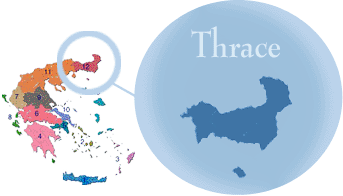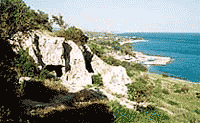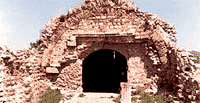
Thrace, being the northeastern part of Hellenism, was the first of all Hellenic counties to suffer from and resist to pressures from eastern neighboring populations. First signs of human presence on this land are estimated to be in an era between 10,000 and 7,000 BC. Neolithic Age findings from the village of Paradimi denote that during the Neolithic ages (4500-3000 BC) there had been a lot of human activity in the area. Later on, during the Bronze Age (3000 - 1100/1050 BC), Thrace started to establish some kind of relationships with various other Hellenic territories, but all that suddenly stopped due to a series of unexpected catastrophes. During the early years of the Iron Age (1050 - 659 BC) the Thracians as stated by Herodotos had developed and were proficient in the art of iron-making and they were also known as great worriers.
First signs of human presence on this land are estimated to be in an era between 10,000 and 7,000 BC. Neolithic Age findings from the village of Paradimi denote that during the Neolithic ages (4500-3000 BC) there had been a lot of human activity in the area. Later on, during the Bronze Age (3000 - 1100/1050 BC), Thrace started to establish some kind of relationships with various other Hellenic territories, but all that suddenly stopped due to a series of unexpected catastrophes. During the early years of the Iron Age (1050 - 659 BC) the Thracians as stated by Herodotos had developed and were proficient in the art of iron-making and they were also known as great worriers.
The same identity is inherited by the Thracian God of the Roman Times, known as the Thracian Rider.  Colonies founded on the Thracian coasts during the 7nth century BC very soon became very prosperous, serving as trade stations, since their location stands between the Hellenic main land and Minor Asia which was at that time full of other Hellenic colonies. Thus, most of them were finally turned into powerful city-states with international relations all over the known world.. During the Persian Wars (4rth century BC), the Thracian cities were members of the Athenian Alliance. By the end of this time the Thracian cities were found to be paying loyalty taxes to the Persian King. This situation was eventually overturned during the days of the Macedonian king Philip the Second, who after a series of continuous war campaigns managed to conquer the entire area. The Macedonian occupation of the Thracian cities went on while Alexander the Great was king of Macedonia, and it ended in the days of the King Persseas who was defeated by the Romans in the first century BC and so Thrace became -- and stayed like that for quite a long - a Roman providence.
Colonies founded on the Thracian coasts during the 7nth century BC very soon became very prosperous, serving as trade stations, since their location stands between the Hellenic main land and Minor Asia which was at that time full of other Hellenic colonies. Thus, most of them were finally turned into powerful city-states with international relations all over the known world.. During the Persian Wars (4rth century BC), the Thracian cities were members of the Athenian Alliance. By the end of this time the Thracian cities were found to be paying loyalty taxes to the Persian King. This situation was eventually overturned during the days of the Macedonian king Philip the Second, who after a series of continuous war campaigns managed to conquer the entire area. The Macedonian occupation of the Thracian cities went on while Alexander the Great was king of Macedonia, and it ended in the days of the King Persseas who was defeated by the Romans in the first century BC and so Thrace became -- and stayed like that for quite a long - a Roman providence.
The foundation of Constantinople in the year 330 AD, was the major reason why the fate of Thrace was bound so tightly with that of the Holly City. The now christened county is being reorganized and walks along the path of the Byzantine Empire. Orthodox monasteries are founded and prosper on the Thracian mountains (Mnt Papikion). In the years to come, Thrace also suffered from rades of the Bulgarian tribes in the 10nth and 11nth century AD, but all these stopped in the days of Byzantine Emperor Vassilios 'B of the Macedonian dynasty (976 - 1025 AD). Unfortunately progress is abruptly halted by the Othoman Turks invasion, the allure of Constantinople (1453 AD) and the violent en-muslism of entire areas. Thrace then has a dark period of Turkish occupation where nothing worth mentioning ever happens.  After all, the land was too close to the Capital of the Othoman Empire (now called Istanbul so as not to remind of the old glorious city that the Turks had destroyed). However during the 19th century Thrace has a small period of development and prosperity which goes on until World War I and the Balkan Wars that followed. Right after that period Thrace is being taken over by the Hellenic and Allay Armies and finally freed in 1920 only to be given away as a present to the Bulgars by the Nazi's during World War II, until final liberation in 1945 . Thrace has a rich cultural tradition mainly because the Thracian Hellenism stands right in the middle of various other populations, such as Bulgarians, Turks, Rumanians and even Russians, thus producing a unique scenery of combinations and influences of various other cultures and traditions. Thracian folk music is cheerful, quick and played with drums violins and pipes. Threcian scenery ranges from picturesque mountain villages to crystal clean sandy beaches -- that have all been awarded with the EEC flag -- and lakes with ducks and swans in them. It is said that in Thrace, every step is a journey and visitors realize that since the first time they put their foot on this really Great Land.
After all, the land was too close to the Capital of the Othoman Empire (now called Istanbul so as not to remind of the old glorious city that the Turks had destroyed). However during the 19th century Thrace has a small period of development and prosperity which goes on until World War I and the Balkan Wars that followed. Right after that period Thrace is being taken over by the Hellenic and Allay Armies and finally freed in 1920 only to be given away as a present to the Bulgars by the Nazi's during World War II, until final liberation in 1945 . Thrace has a rich cultural tradition mainly because the Thracian Hellenism stands right in the middle of various other populations, such as Bulgarians, Turks, Rumanians and even Russians, thus producing a unique scenery of combinations and influences of various other cultures and traditions. Thracian folk music is cheerful, quick and played with drums violins and pipes. Threcian scenery ranges from picturesque mountain villages to crystal clean sandy beaches -- that have all been awarded with the EEC flag -- and lakes with ducks and swans in them. It is said that in Thrace, every step is a journey and visitors realize that since the first time they put their foot on this really Great Land.

